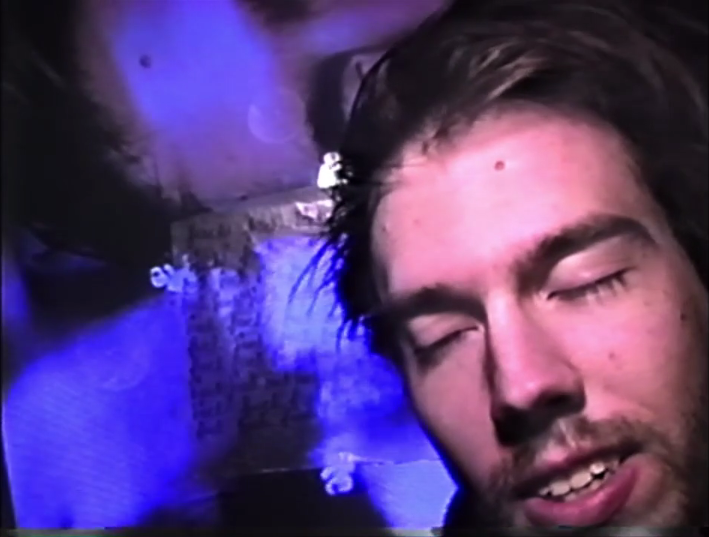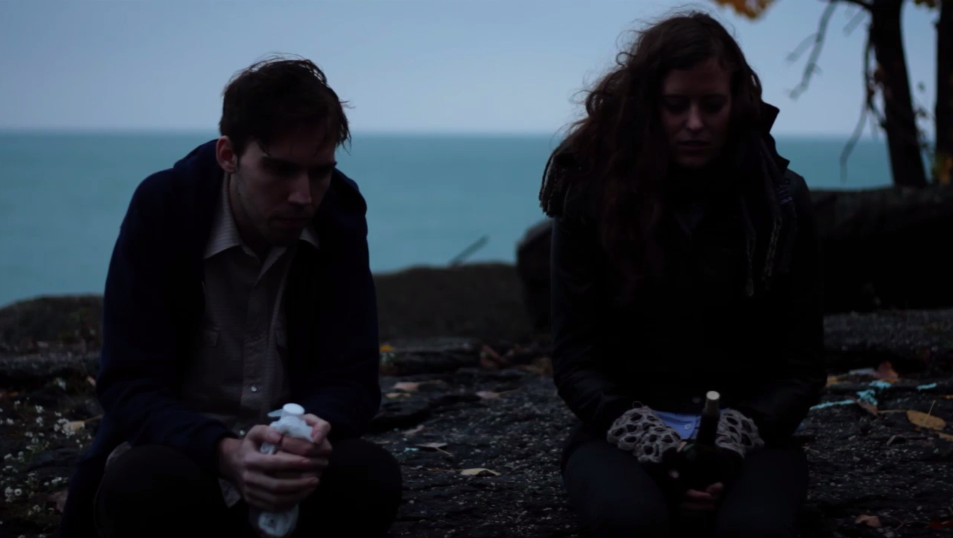“10 minutes is probably too long to make folks listen to such inanity but what would I have done with the remaining film?”
At one point in The Idiot Faces Tomorrow, its titular protagonist is deemed “the most entitled retard I know” by (presumably) a friend. If those seem like harsh words from a trusted confidante, you don’t know this idiot. Cameron Worden’s micro-budget affront, which screens this Sun at 7:00p in 4070 Vilas Hall, is here to question the values of relationships, societal mobility, and the elements of cinema we take for granted. The film’s grain shifts in and out of digital and analog formats, twisting its textures in direct contrast to the aimless, meandering presence of its subject: an emotionally unintelligent, down-and-out twenty-something with no career prospects and zero ambition to change that sad fact.
Anxious for some clarity, I reached out to Worden ahead of the film’s screening at Micro-Wave Cinema:
Your opening sequence is so great. It’s 10+ minutes of the same beat between the protagonist and this really pissed off guy. “Go away.” “Okay, but…” This refusal to take “no” for an answer is our introduction to the character, but at first I felt bad for him, not knowing that this is more or less his personality.
Cameron: It’s a fairly typical opening for a narrative comedy (“A visual that represents the struggle & tone of the story. A snapshot of the main character’s problem, before the adventure begins,”) only that it’s stretched to a painful duration. I found out about Blake Snyder’s Save the Cat screenwriting book only after I finished The Idiot Faces Tomorrow [TIFT]. Snyder lays out 15 “beats” a narrative film should take and there are 15 discreet sections in TIFT. The first seven or so match up pretty well with Snyder’s structure. In its conception, I was thinking of the film as a sort of decrepit mirror of industrial narrative comedy so this alignment isn’t really a coincidence. That first shot is on 16mm (beautiful Ektachrome reversal stock RIP) so the duration of the magazine ended up dictating the duration of the shot. 10 minutes is probably too long to make folks listen to such inanity but what would I have done with the remaining film?
I saw Horse Money a few weeks ago at the Wisconsin Union and that felt loose and freeing by comparison. This is a very stubborn film. I mean that in the best way, and I feel like the older people I work with would find this a spot-on characterization of my generation.
Cameron: Costa is a great favorite of mine and was certainly on my mind during the making of this film. On its surface, the titular hovel of In Vanda’s Room doesn’t look too different from a good many punk houses or artist spaces in this country. The difference is in socioeconomic alignment, where the self-marginalized at least have a say in their marginalization. A lot of TIFT takes places in dark rooms and cruddy basements but nobody is exactly clawing to get out. This isn’t meant to be a slag on young bohemians, but I do think this sort of pathetic inertia gives the film its fascination and is fertile ground for comedy.
The lead actor has this wonderful naturalism in his delivery that really sells his drawn-out, ad nauseum personality. But then other characters’ deliveries are much stiffer and feel more scripted. Speaking generally, the acting feels very hands-off. How much direction did you give?
Cameron: That’s me in the lead! Everybody in this film is a friend, usually playing somebody with roughly an equivalent relationship to me as their screen analogues have to the main character. About half the film is improvised and half is scripted. In general, I gave next to no direction to the performers, only doing an occasional retake if a line reading felt off. A handful of folks in the film have acting experience, a bunch don’t (this was my first time in front of a camera) so there’s a range of energies, which I like. It adds to the general raggedness of the whole enterprise.
There’s this central idea to The Idiot Faces Tomorrow of “digging a hole for one’s self” around your character. What inspired you to write this character?
Cameron: Part of it was the genuine fear that, as an artist, I have no solid function in the world and all of my efforts only serve my ego. It’s a kind of worst case scenario, an exercise that helped me understand that economic function doesn’t inherently grant a life value. I hope the film doesn’t lend itself to easy conclusions and I hope that it doesn’t take a clear, definitive stance on its protagonist’s situation. A significant amount of narrative cinema, particularly American narrative cinema, provides easy identification points and easy lessons for its audience. To my mind, this contains no answers, only ceaseless fumbling forward.
Now that I’m thinking about it, I have no idea who’s starring as whom in this. Your credits are more of a list, and I’m guessing that’s intentional.
Cameron: Almost everybody who acted in the film also held a camera or a boom mic at some point. The production was very small, with a max of four people “on set” at a given time, which was very intimate and very fun. I love the people I worked with, all of whom were very generous with their time (I paid nobody because I’m exploiter scum.) I took inspiration from the great Sly Stone record There’s a Riot Goin’ On, where every player receives identical credit in an undifferentiated list of names.

While your production feels very loose, the visual choices are incredibly deliberate, and not just with your extended long takes. The camera’s clarity is obscured in so many shots where you’re just showing portions of people’s faces. We’re literally not seeing the whole picture.
Cameron: This is partially because I edited this film on a laptop and a close-up of a face is more legible than a wide shot on such a small screen. Each section was shot differently, by different people and while I was a little more hands-on with the cinematography of the film than I was with the acting, specific framing was left to whomever was holding the camera at a given moment. Most of this film is either people sitting and talking or the main character sitting and staring, rather inert actions that don’t exactly make for a visually dynamic cinema. When you zero in on a human face though, there’s a wealth of information conveyed every second. The “Warhol Screen Tests” are a great example of this, with the magnetism of the human face. The close-ups help to bridge the film’s longueurs in this way.
There are super-saturated and grainy portions to this, too. What did you shoot on?
Cameron: The film was shot on 16mm (Ektachrome and color negative stock), 8mm (Ektachrome again and Tri-X black and white reversal stock), VHS, and HD video with a Canon 7D. There’s also a series of still photos taken with a few disposable cameras and a sequence shot in HD but manipulated, compressed and transferred to VHS. Working in this way with this many formats nullifies any concerns about continuity and allows me to keep crews small and shoots intimate.
This premiered online through NoBudge but have you shown this in a setting that gives the audience a chance to wrestle with what you’re doing?
Cameron: Not in its full form. It’s the odd film that works best in a cinema space but is fairly difficult to program for such a space. I love films that take weird shapes, that stretch out or compress their action into 50 minutes. These films, alas, are not compatible with festival screenings, where blocks of time are so frequently allotted before films are even selected. There are a good many micro-cinemas amenable to difficult, wonky cinema but I’ve been slow in reaching out to them. I’m lucky [Micro-Wave Cinema programmer] Brandon Colvin thought enough of the film to include it on this season’s schedule, otherwise it would continue to live solely at NoBudge (a great home for microbudget work, it must be said). The film has yet to screen publicly in Chicago where most of it was shot and where I live, and there’s no sign of this changing any time soon. It’s conceivable that the Micro-Wave screening will be the only time this staggering, sleepy behemoth will be seen on a screen larger than a monitor.
- The Idiot Faces Tomorrow screens Sun, Nov 22 for FREE at 7:00p in 4070 Vilas Hall. Director Cameron Worden will make an appearance afterward.

